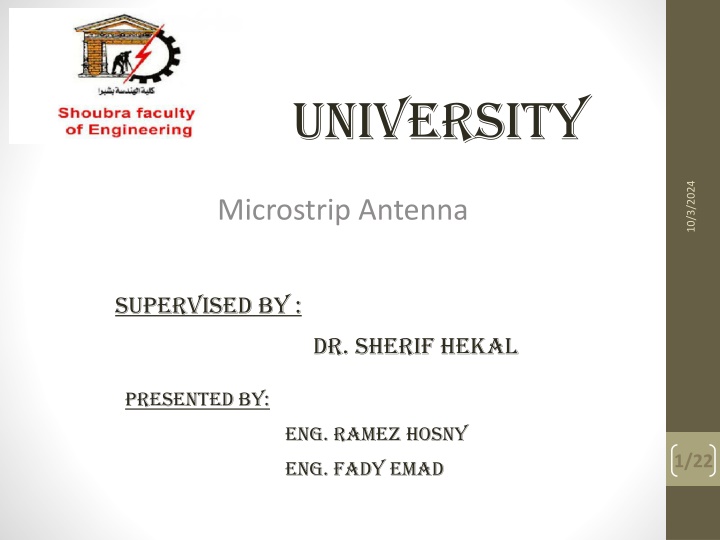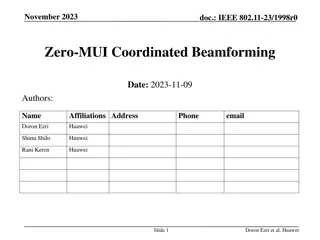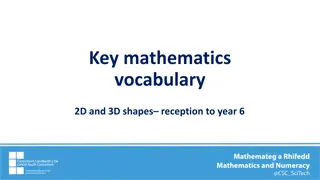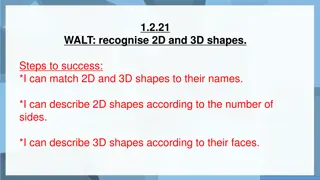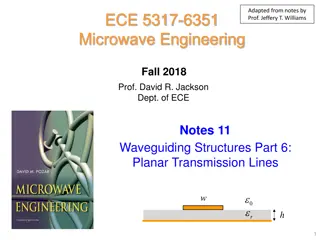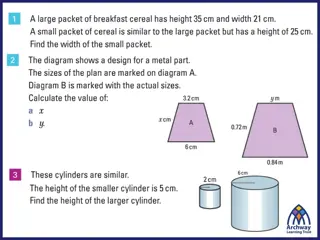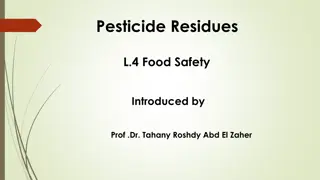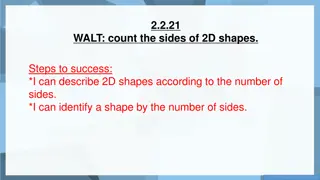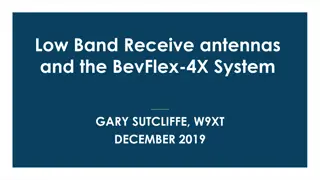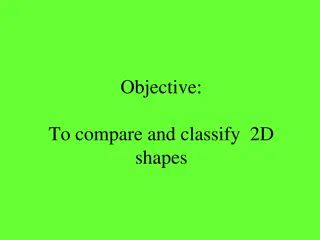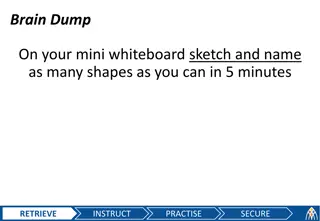Microstrip Antennas: Overview of Types, Shapes, and Substrates
This article delves into the world of Microstrip Antennas, exploring various types, shapes, and substrates used. It covers the advantages, applications, and radiation patterns of Microstrip Antennas, as well as insights on optimizing substrate properties for increased bandwidth and comparing different feed techniques. The content also touches upon the fabrication ease, directivity, and characteristics of Microstrip Patch Antennas.
Download Presentation

Please find below an Image/Link to download the presentation.
The content on the website is provided AS IS for your information and personal use only. It may not be sold, licensed, or shared on other websites without obtaining consent from the author.If you encounter any issues during the download, it is possible that the publisher has removed the file from their server.
You are allowed to download the files provided on this website for personal or commercial use, subject to the condition that they are used lawfully. All files are the property of their respective owners.
The content on the website is provided AS IS for your information and personal use only. It may not be sold, licensed, or shared on other websites without obtaining consent from the author.
E N D
Presentation Transcript
university 10/3/2024 Microstrip Antenna Supervised by : Dr. Sherif HEKAL Presented by: Eng. Ramez hosny 1/22 eng. fady emad
Micro-StripAntennas Outlines : Introduction . Microstrip Antennas Types . Microstrip Antennas Shapes . Types of Substrates(Dielectric Media). Comparison of various types of flat profile printed antennas . Advantages & DisAdvantages Applications of MSAs . Radiation patterns of MSAs . How to Optimizing the Substrate Properties for Increased Bandwidth ? Comparing the different feed techniques . Design Of Microstrip of MSAs .
Introduction In its most basic form, a Microstrip patch antenna consists of a radiating patch on one side of a dielectric substrate which has a ground plane on the other side For good antenna performance, a thick dielectric substrate having a low dielectric constant is desirable since this provides better efficiency, larger bandwidth and better radiation . In genaral Micro strip antennas are also known as PATCH ANTENNAS . These are mostly used at microwave frequencies. Because the size of the antenna is directly tied the wavelength frequency. Micro strip patch antenna or patch antenna is a narrowband width antenna. at the resonant Structure of a Microstrip PatchAntenna
Micro strip antennas are easy to fabricate and comfortable on curved surface. The directivity is fairly insensitive to the substratethickness. Micro strip patch antennas patches are in variety of shapes, such as rectangular , square , triangular and circulator etc. Patch antenna
Microstrip Antennas Shapes a) Single radiatingpatches b) Single slotradiator
Types of Substrates(Dielectric Media) Substratesare: The most commonly used substratesare, 1)Honey comb(dielectric constant=1.07) 2)Duroid(dielectric constant=2.32) 3)Quartz(dielectric constant=3.8) 4)Alumina(dielectricconstant=10) A thicker substrate will increase the radiationpower , reduce conductor loss and improve Bandwidth.
Comparisonof various types of flat profile antennas: Charaterstics Microstrippatch antenna Microstripslot antenna Profile Thin Thin Fabrication Very easy Easy Polarization Both linear& circular Both linear& circular Dual freq operation Possible Possible Shape Any shape Rec &circle
Advantages Low fabrication cost, hence can be manufactured in large quantities. Easily integrated with microwave integrated circuits (MICs). Capable of dual and triple frequency operations. Supports both, linear as well as circular polarization. Low cost , Less size , Low Mass . Mechanically robust when mounted on rigid surfaces. High Performance Light weight and low volume.
Disadvantages Narrow bandwidth associated with tolerence problem Lower Gain(Nearly 6db( . Spurious feed radiation (surface waves, Feed strips, etc.) Most microstrip antennas radiate into half-space . Relatively low efficiency (due to dielectric and conductor losses) . low impedance bandwidth. Extraneous radiation from feeds and junctions . Low power handling capacity.
Solution : Low power and low gain can overcome by arraysconfiguration. Surface wave associated limitations such as poor efficiency,increased mutual coupling , reduced gain and radiation pattern can overcome. The band width can increase up to 60% by using some special techniques.
Applications Used in mobile satellite communication system. Direct broad cast television (DBS). Wire less LAN S. Feed elements in coaxial system GPS system. Missiles and telementry UHF Patch Antennas for Space
Some Of Application: UHF Patch Antennas for Space Antenna Development Corporation, Inc.(AntDevCo) employees have designed and manufactured spacecraft microstrip patch antennas for many small spacecraft programs. These antennas are capable of supporting high data rates to at least 10 Watts of transmitted power. Applications include GPS, NASA SN (Including TDRSS forward/return pairs), radar transponder, The antennas can be supplied with LHCP, RHCP, or linear polarization . UHF Patchantenna
Why we use Microstrip Patch Antennas? Used for some reasons: Flat surface makes them ideal for mounting on airplane Impedance matching fairly simple Microstrip patch antennas have a very high antenna quality factor(Q).
Radiation patterns of MSAs . Radiation patterns of a rectangular microstrip patchantenna The directivity of a microstrip antenna as a function of dielectric constant computed:-
Radiation efficiency, h, and unloaded radiation Q, Q o, as a function of substrate thickness . Figure shows that :A microstrip patch that uses a thicker substrate is more efficient. In addition, as the substrate thickness increases, the radiation Q of the antenna decreases. Thus, impedance bandwidth increases with increasing substrate thickness.
Optimizing the Substrate Properties for Increased Bandwidth The easiest way to increase the bandwidth of an MSA is to : 1) Print the antenna on a thickersubstrate. 2) Decrease the dielectric constant of thesubstrate. 3) Stack two patches on top of each other separated by a dielectric substrate orspacers. A stacked circular patch EMC-MSA fed usinga coaxialprobe.
Comparing the different feed techniques:-
FeedingTechniques: Coaxial feed Microstrip feed Proximity coupled microstrip feed Aperture coupled microstrip feed Line Feed
1-Microstrip Line Feed : In this type of feed technique, a conducting strip is connected directly to the edge of the microstrip patch. This kind of feed arrangement has the advantage that the feed can be etched on the same substrate to provide a planar structure.
-2- Coaxial Feed :- The Coaxial feed or probe feed is a very common technique used for feeding Microstrip patch antennas. The main advantage of this type of feeding scheme is that the feed can be placed at any desired location inside the patch in order to match with its input impedance. This feed method is easy to fabricate and has low spurious radiation. However, its major disadvantage is that it Coaxial Ground Plane Connector Substrate Patch provides narrow bandwidth and is difficult to model since a hole has to be drilled in the substrate . and the connector protrudes outside the ground plane, thus not making it completely planar for thick substrates . Probe fed Rectangular Microstrip Patch Antenna from top Probe fed Rectangular Microstrip Patch Antenna from sideview
3--Aperture CoupledFeed In this type of feed technique, the radiating patch and the microstrip feed line are separated by the ground plane. Coupling between the patch and the feed line is made through a slot or an aperture in the ground plane. Aperture-coupledfeed The coupling aperture is usually centered under the patch, leading to lower cross polarization due to symmetry of the configuration. The amount of coupling from the feed line to the patch is determined by the shape, size and location of theaperture.
4--Proximity CoupledFeed This type of feed technique is also called as the electromagnetic coupling scheme . Proximity-coupledFeed Two dielectric substrates are used such that the feed line is between the two substrates and the radiating patch is on top of the upper substrate. The main advantage of this feed technique is that it eliminates spurious feed radiation and provides very high bandwidth due to overall increase in the thickness of the microstrip patch antenna. This scheme also provides choices between two different dielectric media, one for the patch and one for the feed line to optimize the individual performances. Matching can be achieved by controlling the length of the feed line and the width-to-line ratio of the patch. The major disadvantage of this feed scheme is that it is difficult to fabricate because of the two dielectric layers which need properalignment. Also, there is an increase in the overall thickness of the antenna.
Design Of Microstrip : Where :
Design Of Microstrip : The length L :
